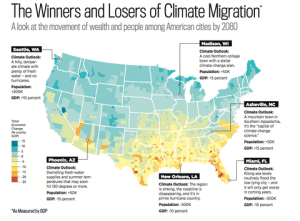
I’ll admit this is one collision of green I had not [truly] considered, but Is the human race too dumb to survive?
Rep. Mo Brooks (R-AL) questioned Duffy on the factors that contribute to sea-level rise, pointing out that land subsidence plays a role, as well as human activity. Brooks then said that erosion plays a significant role in sea-level rise, which is not an idea embraced by mainstream climate researchers. He said the California coastline and the White Cliffs of Dover tumble into the sea every year, and that contributes to sea-level rise. He also said that silt washing into the ocean from the world’s major rivers, including the Mississippi, the Amazon and the Nile, is contributing to sea-level rise. “Every time you have that soil or rock or whatever it is that is deposited into the seas, that forces the sea levels to rise, because now you have less space in those oceans, because the bottom is moving up,” Brooks said.
Most everyone who has reckoned with the possibilities seems to understand that, whatever the fate of humans, the planet will eventually survive. So when we talk about the destruction of the planet, we’re thinking of our own, rather than that of the 3rd Rock itself. I’ve been grappling with this in a different but very related context recently – that is, how to best communicate with the public (industry, citizens, local governments) about the solutions to the challenges wrought by climate change, when the posture of state leaders more resembles that of Congressman Brooks. The stock response is: Stop talking about that! Despite the best efforts of Rembrandt, Descartes, Heisenberg, Jessie Owens and Emily Dickinson, maybe we’re just too dumb. Perhaps we can set a date at some point in the [near] future when we can begin talking about sea level rise, erratic weather, internal displacement, clean water, energy… but maybe that’s just negotiating with stupid. In which case, stupid has already prevailed and Groundhog Day is a truck that drives around town all day, picking up the same cabbages that fell from it earlier this morning.
